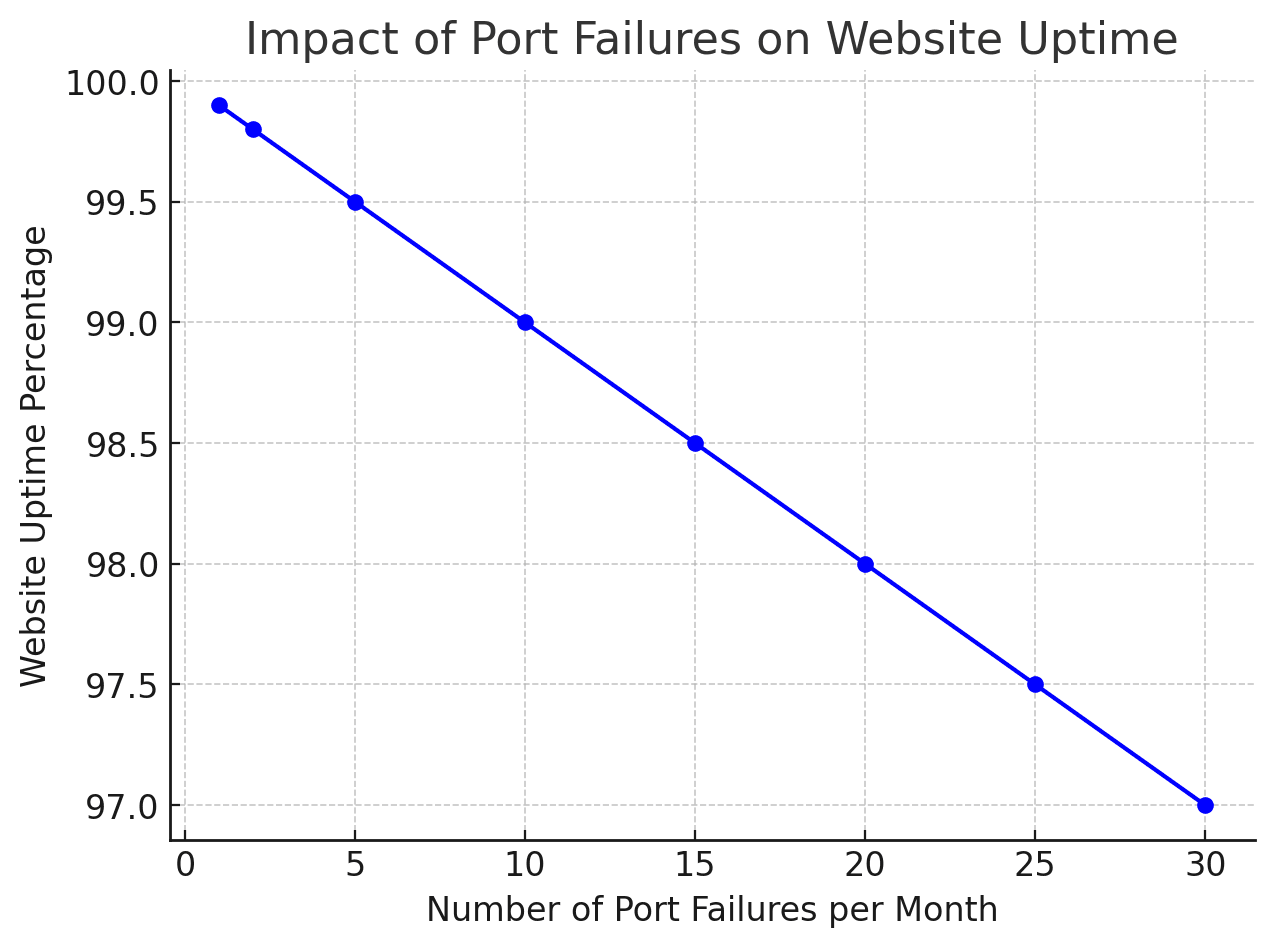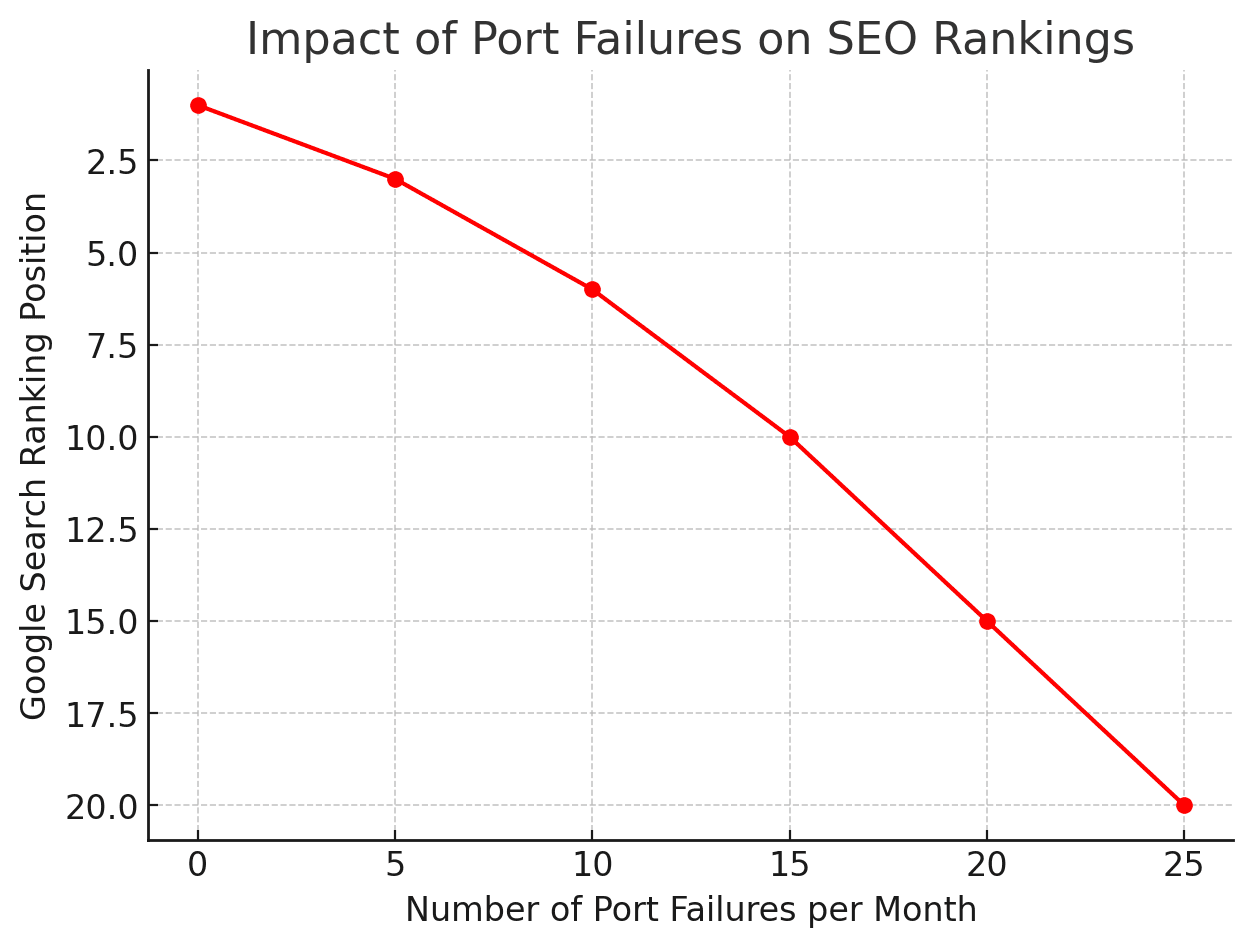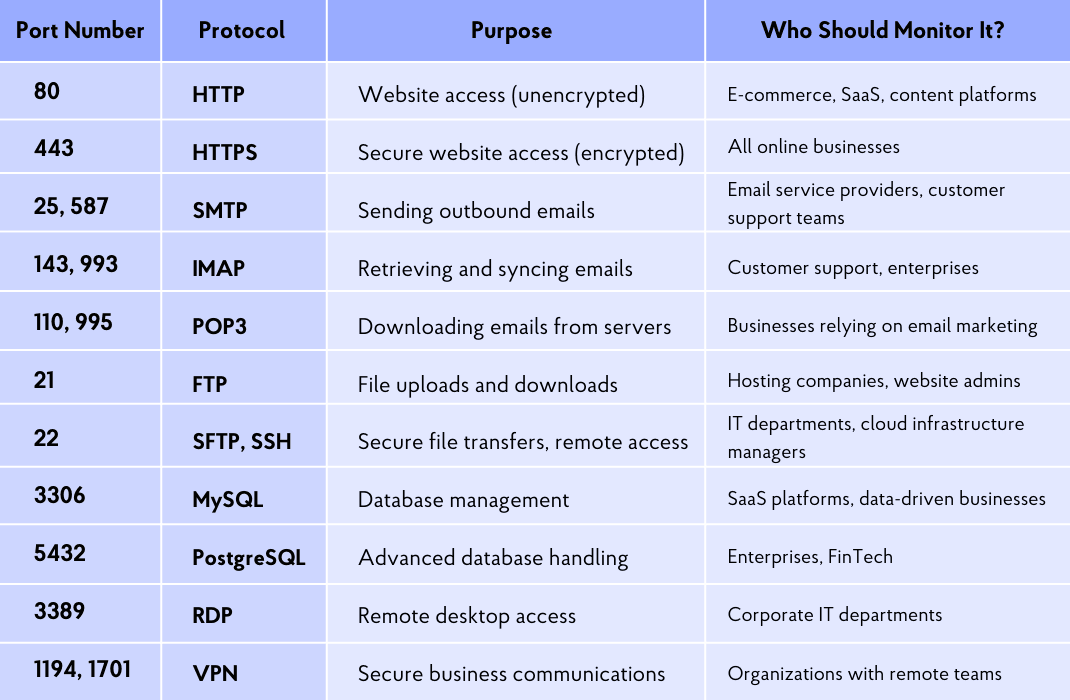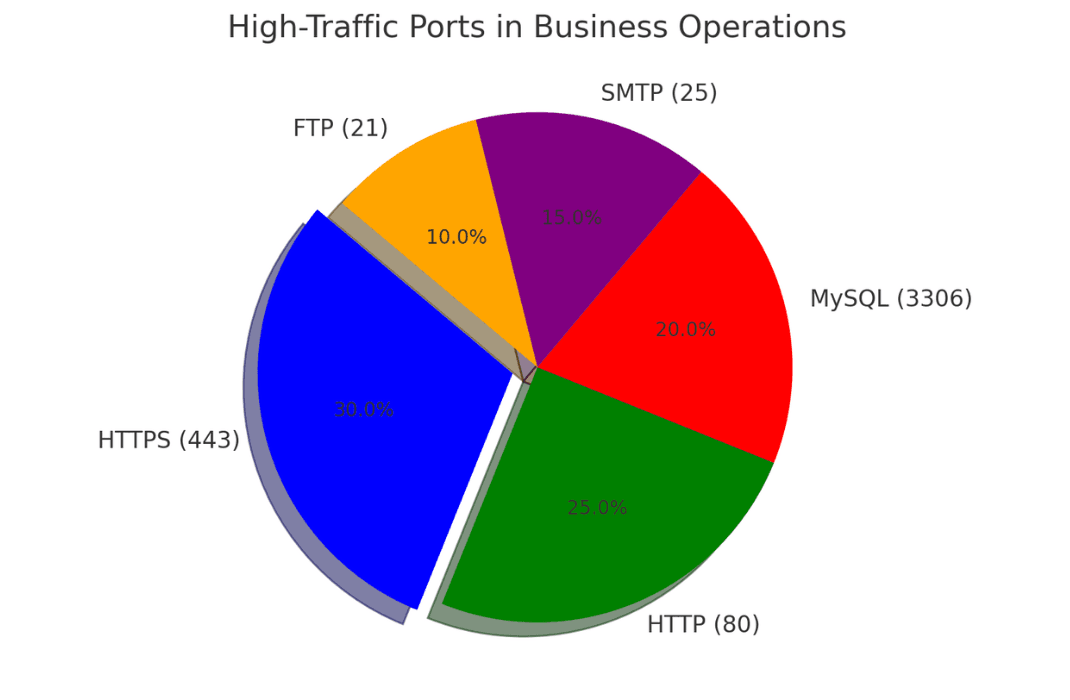In today’s digital environment, businesses rely on multiple online services, platforms, and applications to keep operations running smoothly. However, ensuring their availability and security depends largely on monitoring the right network ports. Choosing the wrong ports—or failing to monitor key ones—can lead to costly downtime, security vulnerabilities, and a poor user experience.
How to Choose the Right Ports for Monitoring Based on Business Processes
Nadiia Sidenko
2025-02-27

Why Monitoring the Right Ports Matters for Your Business
The Connection Between Port Failures and Website Downtime
Each port on a server is responsible for a specific type of communication. When a critical port becomes unresponsive, it can disrupt services such as website access, file transfers, or secure connections. For instance, a failure in port 443 (HTTPS) can make a website inaccessible, leading to downtime that negatively affects revenue and customer trust.
Unmonitored ports can cause various issues, from slow-loading pages to total website outages. According to Cloudflare’s insights on port failures, unprotected and unmonitored ports are among the leading causes of service disruptions and security risks. Regular port monitoring helps businesses detect and resolve issues before they escalate.
A detailed look at port monitoring for online businesses shows how proactive monitoring minimizes downtime and ensures seamless operations.

SEO & Security Risks of Unmonitored Ports
Frequent website downtime due to port failures does not just frustrate users—it also damages search engine rankings. Google and other search engines prioritize sites that offer stable performance. If a site experiences repeated downtime caused by unmonitored ports, search engines may reduce its visibility in search results.
Moreover, security risks are another critical concern. Hackers often exploit open but unmonitored ports to gain unauthorized access to a system. The OWASP Web Security Testing Guide outlines key methodologies for identifying open ports that could expose websites to security vulnerabilities. Monitoring security-critical ports like SSH (22), RDP (3389), and VPN ports can prevent unauthorized access attempts and cyber threats.
Businesses that implement strategic port monitoring can better protect their data and maintain a secure online presence.

Types of Ports and Their Role in Business Operations
Different business processes depend on different types of ports. Monitoring the right ports based on industry-specific needs can improve uptime, security, and operational efficiency.
Essential Ports for Web Services and E-Commerce
Web-based businesses, including SaaS platforms and e-commerce sites, rely on HTTP and HTTPS for seamless connectivity.
- HTTP (80): Standard web browsing and website access
- HTTPS (443): Secure encrypted communication
Failing to monitor these ports can result in customers experiencing page load failures, broken checkout processes, and compromised user trust. A case study on preventing e-commerce checkout failures highlights why HTTPS monitoring is critical.
Email and Communication Ports for Customer Support
Businesses relying on email communications must ensure their email servers remain available:
- SMTP (25, 587): Sending outbound emails
- IMAP (143, 993): Retrieving and syncing emails across devices
- POP3 (110, 995): Downloading emails from servers
Monitoring these ports ensures that customers and employees don’t face disruptions in email communications.
Data Transfer Ports for Cloud & Hosting Services
Cloud-based platforms and web hosting services require reliable file transfer and database access:
- FTP (21), SFTP (22): Secure file uploads/downloads
- MySQL (3306), PostgreSQL (5432), Microsoft SQL Server (1433): Managing databases
Without monitoring, businesses may face data loss, slow performance, or unauthorized access to critical systems.
Security-Critical Ports for Protecting Business Infrastructure
Cybersecurity is an ongoing concern, and businesses must monitor high-risk ports to prevent intrusions:
- SSH (22): Secure remote access for system admins
- RDP (3389): Remote desktop protocol, often targeted by hackers
- VPN Ports (1194, 1701): Secure business connections
The CISA guidelines on secure port management provide recommendations for safeguarding these critical ports from cyberattacks.

How to Determine Which Ports to Monitor for Your Business Needs
Selecting the right ports to monitor depends on your industry, service type, and operational requirements.
Identifying Mission-Critical Ports Based on Industry
Different industries have unique port monitoring requirements:
- E-commerce & SaaS → HTTPS (443), Database Ports (3306, 5432)
- Financial Services → Email Ports (587, 993), VPN (1194)
- Healthcare Platforms → Secure Data Transfer Ports (SFTP, 22)
- Corporate VPNs & Remote Work → RDP (3389), SSH (22), VPN (1701)
Monitoring for High-Traffic and Load-Intensive Services
Some ports handle high volumes of requests and should be monitored more frequently:
- Web traffic (HTTPS 443)
- Database queries (MySQL 3306, PostgreSQL 5432)
- Cloud storage uploads/downloads (SFTP 22, FTP 21)

The NIST Special Publication 800-92 outlines best practices for network security monitoring to ensure high availability.

Best Practices for Configuring Port Monitoring
Setting Custom Monitoring Rules for Different Port Categories
To get the most value from port monitoring, businesses should set up custom monitoring rules for each category.
- Web Services: Real-time uptime tracking
- Email & Communication: Spam and delivery monitoring
- Security Ports: Unauthorized login attempt detection
Configuring Real-Time Alerts for Critical Ports
Businesses should configure real-time alerts for essential ports to react instantly to failures or attacks.
- Set immediate notifications for HTTPS, VPN, SSH, and database ports
- Automate responses for suspicious activity
- Use cloud-based monitoring for global visibility
Reviewing Monitoring Data for Long-Term Performance Optimization
By analyzing historical monitoring data, businesses can:
- Detect recurring port issues
- Optimize server performance
- Prevent future failures
The Cisco guide to network port security provides valuable insights into securing and optimizing port monitoring configurations.

Case Studies – Businesses That Improved Operations with Smart Port Monitoring
How a SaaS Company Reduced Downtime by 70% by Monitoring the Right Ports
A SaaS company struggling with frequent outages optimized its port monitoring strategy and reduced downtime by 70% by tracking HTTPS and database traffic.
How an E-commerce Business Prevented Checkout Failures with HTTPS Port Monitoring
An e-commerce company prevented 30% of checkout failures by monitoring HTTPS (443) and database (3306) connections, improving both customer experience and SEO rankings.
Glossary of Terms
- Port Monitoring: The process of tracking the availability and performance of specific network ports.
- Network Port: A virtual endpoint for network communication, associated with a number (e.g., 80 for HTTP, 443 for HTTPS).
- Downtime: The period during which a service or website is unavailable.
- Firewall: A security system that controls incoming and outgoing network traffic.
- SSH (Secure Shell): A protocol for securely accessing remote servers.
- RDP (Remote Desktop Protocol): A Microsoft protocol used for accessing remote desktops.
- IANA (Internet Assigned Numbers Authority): The organization responsible for managing port assignments.
- TLS/SSL (Transport Layer Security/Secure Sockets Layer): Protocols that provide encrypted communication over networks.
Frequently Asked Questions
1. What is port monitoring, and why is it important?
Port monitoring is the process of tracking the availability and security of network ports to prevent downtime and security risks. It helps businesses detect failures before they impact users.
2. Which ports should I monitor for my business?
Essential ports to monitor depend on your business needs. Commonly monitored ports include HTTP (80), HTTPS (443), SMTP (587), FTP (21), MySQL (3306), and SSH (22) for security and performance.
3. How does port failure impact SEO rankings?
Frequent downtime due to port failures can reduce search rankings, as search engines prioritize sites with high uptime and performance.
4. Can port monitoring prevent cyberattacks?
Yes. Monitoring security-critical ports like SSH (22) and RDP (3389) helps detect unauthorized access attempts, reducing the risk of cyberattacks.
5. What tools can I use for port monitoring?
There are multiple port monitoring tools, including MySiteBoost’s Port Monitoring Service, which provides real-time alerts and historical performance analysis.
6. How often should ports be monitored?
Critical ports should be monitored continuously, with real-time alerts configured for immediate response to failures.
7. What is the difference between port monitoring and network monitoring?
Port monitoring focuses on specific communication endpoints, while network monitoring examines overall traffic, latency, and connectivity issues. Learn more in this comparison.
8. Is automated port monitoring better than manual monitoring?
Yes. Automated monitoring tools provide instant alerts, detailed analytics, and proactive threat detection, reducing downtime and enhancing security.
Conclusion
How Smart Port Selection Enhances Business Stability
Choosing the right ports for monitoring helps businesses maintain uptime, improve security, and enhance user experience. By implementing real-time alerts, historical data analysis, and tailored monitoring strategies, businesses can prevent outages and security threats.
To achieve a robust and proactive monitoring setup, consider integrating advanced port monitoring solutions like MySiteBoost’s Port Monitoring Service, ensuring that your business remains secure, accessible, and optimized for success.
Why Monitoring the Right Ports Matters for Your Business
The Connection Between Port Failures and Website Downtime
SEO & Security Risks of Unmonitored Ports
Types of Ports and Their Role in Business Operations
How to Determine Which Ports to Monitor for Your Business Needs
Best Practices for Configuring Port Monitoring
Case Studies – Businesses That Improved Operations with Smart Port Monitoring
Glossary of Terms
Frequently Asked Questions
Conclusion